029 - Gardening in Sandy Soils
Introduction
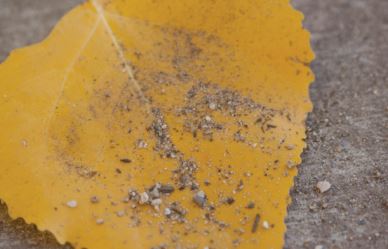
Sand particles can be seen by the naked eye.
Sandy soils must be managed differently from other soils to ensure healthy plant growth. Sand-dominated soil textures include loamy sand (at least 70% sand) and sand (at least 90% sand). Soil texture can be determined by a soil test (see more information on soil testing in Utah). Generally, soils that contain greater than 70% sand are considered unacceptable as topsoil material due to poor water and nutrient retention capacities (see USU Extension Topsoil Quality Guidelines for Landscaping).
What is Sand?
Sand is the largest of the three soil particle sizes, sand, silt and clay. Sand is 0.05 to 2 millimeters in diameter. Wet sandy soil feels gritty when rubbed between two fingers and does not maintain its shape when formed into a ball. Individual sand particles also can be seen with the naked eye. Compared to other soil textures, sand has low surface area and low charge, and hence, does not attract and retain water or nutrients. Due to this quality, sand freely drains and is typically nutrient poor. Natural sands with a variety of particle sizes are difficult to compact; however, dune and beach sands with more uniform particle sizes will pack tightly over time. Sandy soils provide good gas diffusion around plant roots, even when tightly packed.
How Can Sandy Soils Be Improved?
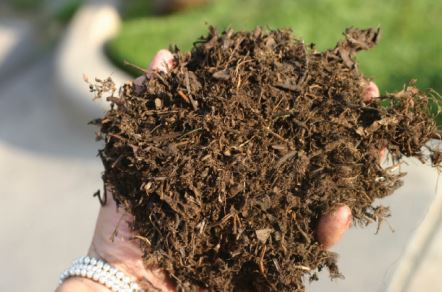
Organic matter is the best amendment for sandy soils.
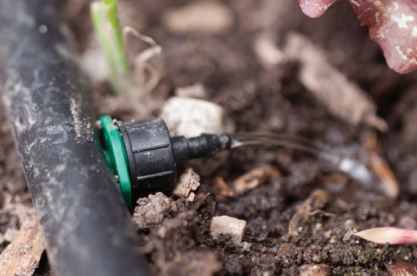
Position drip emitters close to plant roots in sandy soils.
The best amendment for sandy soils is organic matter. Organic matter refers to materials derived from once-living sources. Composted tree bark, wood chips, straw, or leaves, manures and green-waste are all examples of organic matter. Organic matter that is low in nitrogen, like wood, bark, and straw, needs to be composted first before it can be incorporated into the soil. High nitrogen and previously composted materials can be directly incorporated. Nurseries, garden centers, or composting companies sell many different mixtures of organic matter. Read the label or ask for a list of ingredients so you know exactly what you are purchasing. You can also make your own compost at home. Compost is used rather than raw organic matter because it usually has more nitrogen and is less likely to tie up minerals or contain toxic materials. See the USU Extension fact sheet Backyard Composting in Utah for more information on making compost. Clay is not a good amendment option for sandy soils because by mixing the wrong proportion of clay and sand, you might produce a material similar to low-grade concrete. Any time organic matter or other soil amendments are added to soils, they should be thoroughly mixed-in.
What Are Management Implications for Gardening in Sandy Soils?
Sandy soils should be managed differently from other soil textures with higher percentages of clay. Because sand freely drains, it must be irrigated frequently to provide adequate water for plant growth. Water moves rapidly downward through sand and does not spread laterally to any great extent. Since water will not move much laterally, when using drip irrigation in sand it is important to position drip emitters directly above the root zone to ensure that plants get water. The water intake rate of sandy soil is 1 to 10 inches per hour and it takes approximately half an inch of water to recharge a one-foot depth of sandy soil.
Sandy soils must also be fertilized more frequently than soil with other textures since nutrients are not retained on sand surfaces around plant roots for long. Adding organic matter will improve both the water-holding and nutrient-retention capacities of sandy soils. Sandy soils may not provide adequate physical support for plants with heavy tops, like trees. Therefore trees may need to be staked for the first few growing seasons to prevent them from falling over from wind or heavy snow and ice.
What Types of Plants Grow Well in Sandy Soils?
Plants that prefer well-drained, and often droughty root zone conditions grow well in sandy soils. Gardeners may experience difficulties growing plants that prefer higher moisture levels because plantavailable moisture in sand is used much quicker than with finer textures, like clay. Although most tree root growth is shallow, certain species, like spruce, have very shallow roots and should not be grown in sandy soils. For a listing of trees that are tolerant of dry soils, see TreeBrowser (under "Select Characteristics," choose “Tolerance of...” and select a level of drought resistance). There is also a listing of a variety of water-wise plants.
A few examples of trees and shrubs found in Utah that will grow well in sandy soils and that are very drought tolerant are included below.

Utah serviceberry is very drought tolerant and well adapted to growing in sandy soils.
| Common Name (* indicates native to Utah) | Scientific Name |
|---|---|
| Agave, Utah* | Agave utahensis |
| Apache Plume* | Fallugia paradoxa |
| Ash, Singleleaf* | Fraxinus anomala |
| Boxelder or Ash-leaved or Manitoba Maple* | Acer negundo |
| Cliffrose* | Purshia mexicana |
| Coffeetree, Kentucky | Gymnocladus dioicus |
| Corktree, Amur | Phellodendron amurense |
| Cypress, Arizona | Cupressus arizonica |
| Elm, Camperdown | Ulmus glabra ‘Camperdownii’ |
| Elm, Lacebark or Chinese | Ulmus parvifolia |
| Elm, Siberian or Chinese | Ulmus pumila |
| Fernbush* | Chamaebatiaria millefolium |
| Fremont Holly* | Mahonia fremontii |
| Ginkgo or Maidenhair Tree | Ginkgo biloba |
| Goldenraintree | Koelreuteria paniculata |
| Green Mormon Tea* | Ephedra viridis |
| Hackberry, Common | Celtis occidentalis |
| Hawthorns | Crataegus species |
| Honeylocust | Gleditsia triacanthos |
| Junipers | Juniperus spp. |
| Maple, Tatarian | Acer tataricum |
| Mountain-mahogany, Curlleaf* | Cercocarpus ledifolius |
| Mountain-mahogany, Littleleaf* | Cercocarpus intricatus |
| Mulberry, Red | Morus rubra |
| Mulberry, White | Morus alba |
| Oaks | Quercus species |
| Oak, Gambel* | Quercus gambelii |
| Oak, Shrub Live* | Quercus turbinella |
| Pines | Pinus spp. |
| Pinyon, Singleleaf* | Pinus monophylla |
| Pistache, Chinese | Pistacia chinensis |
| Rabbitbrush, Rubber* | Chrysothammus nauseosus |
| Rubber Tree, Hardy | Eucommia ulmoides |
| Sage, Big* | Artemisia tridentata |
| Sage, Black | Artemisia nova |
| Sage, Dorr* | Artemisia dorrii |
| Sage, Fringed | Artemisia frigida |
| Sage, Sand* | Artemisia filifolia |
| Saltbush, Fourwing* | Atriplex canescens |
| Serviceberry | Amelanchier spp. |
| Shadscale* | Atriplex confertifolia |
| Zelkova, Japanese | Zelkova serrata |
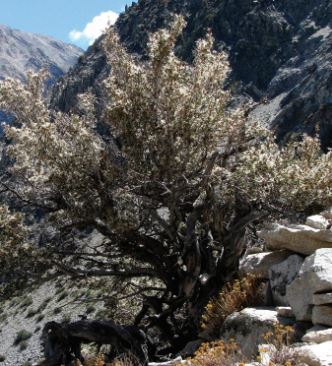
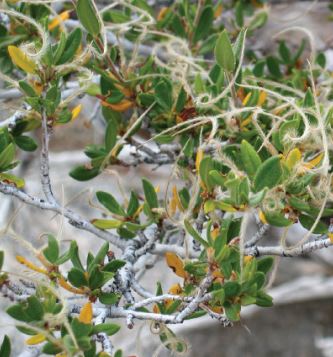
Resources
Many resources are available for people interested in learning how to garden in sandy soils:
- USU Soil Testing Lab open to the general public
- USU Extension Topsoil Quality Guidelines for Landscaping
- USU Extension fact sheet Backyard Composting in Utah for more information on making compost
- Tree Browser - Visit the USU Tree Browser website for photos and identification information for over 240 tree species.
- Water-Wise Plants for Utah Landscapes - Visit this website for a comprehensive guide to water-wise plant selection in Utah. Many other planting criteria are available to choose from.
- Photo Credits Utah serviceberry: Flickr user “Tony Frates”
- Mountain-mahogany (top): Wikimedia Commons user “Davefoc”
- Mountain-mahogany (bottom): Wikimedia Commons user “Dcrjsr”
Acknowledgement and Additional Information
We thank the Washington State Conservation Commission (16-34-FW) Firewise funding to the Central Klickitat Conservation District (KGA). Firewise, Fire Adapted Communities, Ready Set, Go, Firewise, Fire Adapted Communities seek to share information with residents on what you can do to successsfully prepare for a wildland fire. Please contact your local fire department, Forestry, Fire and State Lands, Bureau of Land Management, or US Forest Service office or Utah Wildfire Info to learn about your area’s threat for wildland fire and the wildland-urban interface.
Published June 2015.

